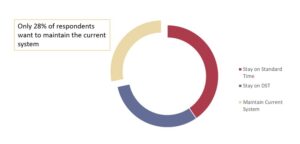Twice a year, Americans find themselves questioning if clocks should spring forward or fall back. While the search interest in daylight saving time (DST) in general has not changed much over the last few years, more and more people are starting to ask questions, specifically why.
From the end of daylight saving in November 2017 to the end of daylight saving in November 2021, search interest for [what is the reason for daylight savings] increased 170%, according to Google Trends.
According to a 2019 poll from the Associated Press-NORC Center for Public Affairs Research, more than 70% of those surveyed do not want to continue changing the clocks. More specifically, the research found that:
- 40% would prefer to stay on standard time year-round
- 31% would prefer to be on daylight saving time year-round
- 28% would prefer to maintain the current system
As Americans demonstrate an increased interest in the “why” behind DST, more people are searching for information about stopping daylight saving. For example, search interest for [which states are getting rid of daylight savings] increased 250% YoY, while search interest for [states opting out of daylight savings time] increased 130% YoY.
States Want to Stop the DST Transition
This uptick in interest is not unfounded, though. In the last four years, eighteen states have passed legislation or resolutions to provide for year-round DST, according to the National Conference of State Legislature.
So why are residents in each of those states still changing their clocks twice per year?
Because, for states to remain on daylight saving time, a change to federal law is required. Despite the preference demonstrated at the state-level, Americans are still unable to stay on DST year-round.
However, both Hawaii and Arizona (except for the Navajo Nation), remain on standard time, meaning they do not fall back or spring forward each year. Hawaii got rid of DST in 1967 and Arizona quickly followed suit in 1968.
It’s important to note that these states are not remaining on DST but are instead remaining on standard time. Under the Uniform Time Act of 1966 (which standardized DST across the United States), states may exempt themselves from DST (aka remain on Standard time); however, if they choose to observe DST, it must begin and end on the federally selected dates (aka states cannot remain full-time on DST without a federal change).
The Case for Remaining on DST
Even though states cannot opt into DST permanently without a federal change, they have a good case for remaining on DST year-round. In addition to the simple annoyance of having to change the clocks, our temporary DST system also has negative effects on sleep. According to Christopher Barnes, a sleep deprivation researcher, changing the clocks negatively impacts our circadian rhythms. He says, “The following Monday, we’ve discovered that people have about 40 minutes less sleep. Because we’re already short on sleep to begin with, the effects of even 40 minutes are noticeable.”
Additionally, research has linked DST with an uptick in heart attack risk in the day after adjusting the clocks. The Monday after springing forward was associated with a 24% increase in heart attacks; however, the day after falling back saw the opposite, with a 21% decrease in heart attacks. Researchers have a theory that “perhaps the reason we see more heart attacks on Monday mornings is a combination of factors, including the stress of starting a new work week and inherent changes in our sleep-wake cycle.” The natural stress and sleep impacts of a typical Monday morning are then compounded by less sleep after setting the clocks forward.
The negative effects don’t stop there. According to a 2020 study, fatal car crashes increased by 6% after the spring DST transition, while there were no effects during the fall back period. This research further supports the argument that less sleep as a result from the DST transition may be to blame.
The Bottom Line
At the end of the day, states have a case for getting off of the current clock-changing cycle. As more legislation and resolutions are passed to remain on DST, more people seem to be taking note and turning to search for answers – why do we even participate in such a seemingly negative practice and how do we get out?

![Do We Really Need Daylight Saving Time? search interest increase for [what is the reason for daylight savings]](https://www.mattressclarity.com/wp-content/uploads/2022/03/search-interest-increase-300x152.jpg)

